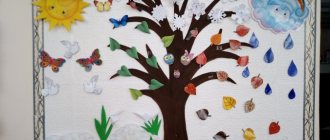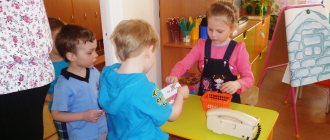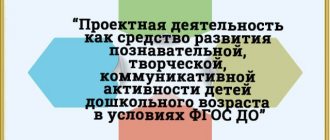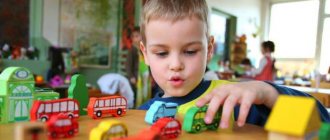Relevance of technology of project activities in preschool educational institutions
Relevance of technology of project activities in preschool educational institutions
The importance of project activities today is due to a number of reasons. Firstly, the provisions of the Federal State Educational Standard for Preschool Education to the structure of the main educational program orient preschool institutions to abandon the educational model of teaching and develop manifestations of independent cognitive activity in children, which is entirely consistent with the principles of the technology of project activity, namely: the content of the project is a complex of different types activity, and independent research is an indispensable part of it. Secondly, project activities were included in the structure of the approximate basic general education programs of preschool education. And thirdly, the technology of project activity is widely used today in school, both in class and in extracurricular activities, which guides preschool institutions towards the formation of skills and prerequisites for project activity already at preschool age.
We can add one more reason for the relevance of project activities: the implementation of projects in preschool educational institutions contributes not only to the development of independent cognitive activity and research skills in children, but also to the reorientation of the thinking of teachers and educators when building the educational process. After all, it’s no secret that the introduction of the Federal State Educational Standard for Educational Education not only highlighted the problems of restructuring the educational process, but also revealed problems associated with the need to train teaching staff to work in new conditions. Mastering the technology of project activities by a teacher automatically reorients him from implementing an educational model to a model of joint activities with children.
Thus, the relevance of design technology in preschool educational institutions is determined both by modern requirements and the needs of children and teachers in the modern quality of educational activities.
Main features, stages and elements of technology of project activities.
What activities can be called project activities?
Here are a few fundamental differences between project activities.
Firstly, this is the activity
,
which
is
the project method
.
The project method
is a set of techniques and actions to achieve a didactic goal through a detailed development of the problem, which should result in a very real, tangible practical result, formalized in one way or another.
That is, to put it simply, it is a set of sequential actions.
can be identified :
- organizational,
during which teachers carefully prepare for the project:
- develop an idea and set project objectives,
- plan the main stages and structure of the project,
- pre-formulate the problem put forward for solution,
- select literature, visual and didactic material,
- conduct a survey and assess the level of knowledge of children on the topic of the project, etc.;
- productive,
representing the joint activities of children and adults to solve the problem and objectives of the project:
- introduction to the problem (“getting used to” the “plot” situation),
- formulation of the problem,
- joint planning and discussion of upcoming joint or individual activities,
- immediate step-by-step solution to the problem in accordance with the established plan;
- presentational
(preparation and presentation of performance results),
- final,
at which there is a joint discussion of the progress and results of the project, and the formulation of a new problem.
Features of technology and methodology of project activities in work
with preschool children
List of features of project activities in preschool educational institutions
can be quite long, since the specifics of the age and development of preschool children are quite peculiar and unique. We will highlight several of the most characteristic features.
- The need for the participation of the teacher as an organizer and coordinator of activities in the project.
Of course, this participation should be unobtrusive. The teacher must understand that he is only an assistant on the path to the child’s independence and help should not consist of edification and performing certain actions for the child. Help can be expressed in the form of suggestions, assumptions: “What if we try?”, “I would advise using it,” “It seems to me that we need ....” etc.
- The need to think through the project activity plan in advance,
since the skills of independent activity planning in preschool children are not sufficiently developed. Many preschool teachers will agree with me that if during the project, after identifying the problem, you ask the children the question “How should we act?”, then only a few children will actively propose options for action, and the rest will either remain silent or repeat what has already been said. This suggests that children do not have sufficiently developed skills for independent activity planning. Have we given them this task often enough? Let’s be frank, the methodology of “past” pedagogy oriented us toward teaching “by example,” i.e. The teacher gives this or that example, and the children must repeat and assimilate it. And educational activities always “went” according to our plan. This was the way it was accepted. Today, priorities are changing and you and I need to learn to provide the child with the opportunity to demonstrate independence both in the process of planning activities, and in the process of organizing and implementing them. The difficulty is, I repeat, that these skills are poorly developed in children. And that is why the teacher must have a preliminary project plan, which, in no case, is offered as the only possible activity option. This plan is a help and hint for the teacher, so that if children have difficulties when planning an activity (and they definitely will), they can unobtrusively offer their options. For example: “Seryozha, do you think it’s possible to organize an exhibition and sale of vegetables?” (project “Vegetables”) or “What do you think, is it possible in a group to create a model of the Universe with many planets and distant stars?” (project "Cosmos").
- The need for a teacher to create a space of possibility,
since the children themselves will find it difficult to create it. The term "space of the possible"
can be characterized as a set of certain subject and material conditions necessary for the full implementation of the project. Obviously, any project requires many different attributes to execute as intended. For example, to solve the problem of choosing cups for constructing pencil holders, so that research activities are truly research-based, you need many different cups: glass, plastic, cardboard, plastic bottles, with a small bottom and a large one, with a wide “neck” and with narrow, etc. In order to correctly compare objects, analyze their properties and qualities, and choose the appropriate shape, a correct and competent selection of materials is necessary. A schoolchild could absolutely calmly make this choice on his own, but this is very difficult for a preschooler. Therefore, the teacher must create this space of the possible, somewhere from what is in the group, somewhere with the help of employees or parents.
So, project activity today is an innovation for many and requires progressive development. But in accordance with modern requirements, project activities should take their rightful place, both in the educational practice of each preschool institution, and in the “arsenal” of developmental technologies of a competent teacher of the 21st century.
Features of research, creative and normative projects
in preschool educational institutions
In order for teachers to navigate the similarities, differences, and features of these types of projects, they could more freely “unfold” project activities with children both in the process of direct educational activities and during daily routine moments, It is necessary to take into account the specifics of children's projects.
From the older group, children are expected to participate in three types of projects: research, creative and normative.
At the same time, separate elements of project activities are provided for younger children:
- at the age of 3-4 years, the productive activity of children is considered as a way of realizing that the “product” of creative activity is the author’s result of purposeful children’s activity;
- at the age of 4-5 years, research activities are included in the general system as a means of children’s active search for answers to questions that interest them.
So, starting from the senior group, one of the tasks is to create conditions for joint implementation of projects of 3 types with children: research, creative and normative.
Let's take a closer look at each of the identified types of projects.
Research projects
According to many teachers, research projects are the most difficult to implement in kindergarten.
Research project
is aimed at developing in children natural scientific ideas about the properties of substances (water, snow, ice, stone, wood, etc.), natural phenomena (snowfall, rain, thunderstorms, etc.), historical events, living conditions of plants and so on.
Possible topics for research projects:
- “Why is the water clear?”
- "Strength of materials"
- "Secrets of our plants"
- “How do you get cream?”
- "Drowning - not drowning"
- “Why does the water disappear?”
- “What was our city like 100 years ago?”
- “When snails appear”, etc.
When conducting a research project, a series of steps can be used. Let's give one of the options.
Stages of a research project
- stage:
introduction to the problem,
involves familiarizing children with the topic of the project and its semantic meaning. - stage:
formulation of a problem
or research task. At this stage, several options are possible:
- collective formulation and discussion of one problem and, accordingly, joint implementation of measures to solve it;
- The research task is determined for each of the children or for small subgroups depending on the interests and desires of the children.
Stage III
:
Project work.
Here children, depending on the chosen option (collective, subgroup, individual) activity, carry out activities to solve a research problem and draw up a project in the form of a poster, magazine, book, etc.
Stage IV:
project protection.
On the day of defending the project, children, with the help of their parents or educators, hang their sketches on stands. Then each child (if this is an individual project) or selected representatives (if this is a subgroup or collective project) talk about the work done, pointing to relevant images, notes, etc.
Stage V:
exhibition of projects.
Holding an exhibition of completed research projects will highlight the importance and significance of the work done by the children. Also, this exhibition can be used to consolidate children’s knowledge about the topic of the project in the process of discussing the books, magazines, posters and exhibits on display.
Creative projects
Creative projects
- the type of project activity that is closest and most familiar to educators. The main feature of creative project activity is that during it a new, creative product is created.
Possible topics for creative projects:
- “What should I give my mom?”
- “What is it like, the world of fairy tales?
- "New Year's Eve"
- "The World of Magic Colors"
- "Super Hat"
- "Gardener's Journal"
- “Dough products”, etc.
Stages of a creative project (approximate version)
- stage:
introduction to the problem,
which involves entering into the meaning of the upcoming activity. - stage:
formulating a creative task or problem
that needs to be solved during the project and which will activate children for subsequent creative activities. - stage:
discussion of options,
development of ideas for creativity. At this stage, several scenarios are possible:
- choosing a project topic together with the children;
- discussion of options for action on a topic proposed by the teacher.
In the first case, the topic of the project will directly depend on the interests of the children. In the second case, the content of the activity will depend on the interests and preferences of the children.
At the end of stage III of the creative project, you can invite children to sketch their ideas and prepare messages for defense (perhaps with the help of their parents or in small groups).
- stage
: protection of ideas
When defending ideas and activity options put forward by children, you can propose a plan of supporting questions to which children will have to answer:
- What do you suggest?
- Who can participate?
- Why is this interesting? and so on.
You can spend from one to several days getting to know the ideas put forward by children (depending on the scale of the project), giving children the opportunity to convey and explain their ideas to each other in an atmosphere of free communication.
- stage:
voting.
Upon completion of the defense of ideas, you can organize a kind of voting using chips, flags, stickers, etc., with which children will have to confirm their choice of one or more options, depending on the teacher’s setting. The teacher can give such an instruction approximately as follows: “4 ideas that have collected the most stickers will take part in the project” (if actions are selected) or “The project topic that collects the most chips will win” (if the project topic is selected), etc. .
Of course, if you have time and conditions allow, you can implement all the children’s ideas, or offer the “losers” the mandatory inclusion of their ideas in the next project, or advise them to carry out the project
- stage:
drawing up an action plan.
Once an idea or ideas have been selected, the question “How should we proceed?” can be discussed. After discussion, draw up a plan, determine the sequence of actions, options for final activities, etc.
- stage
:
Execution of the project plan.
The teacher helps the children
organize work on the project: divide into teams or give out individual assignments, involve parents, kindergarten specialists, etc.
- stage:
presentation.
Carrying out the final events of the project (celebration, exhibition, concert, presentation of a book, magazine, etc.), which is what the entire project was conceived for.
Regulatory projects
The program interprets the regulatory draft
as an activity aimed at developing certain norms and rules of behavior in a children's team.
Many teachers, quite rightly, in our opinion, note that the implementation of normative projects is not limited to just studying the rules of the children's group. This can include the child’s immediate social environment: home, school, library, store, street, etc. Rules for safe behavior and traffic safety - all this can also be included in the scope of regulatory projects.
Possible topics for regulatory projects:
- "Rules of behavior in the group"
- “What is kindness?”
- “Why is it necessary to help the younger ones?”
- "Good habits"
- "Healthy food"
- "Health is movement"
- “Why you need to wash your hands”, etc.
Thus, we can conclude that the main meaning and purpose of project activities
: support for the child’s interests, the implementation of his own plans, the development of cognitive activity and creativity of children’s thinking, the acquisition of experience in the child’s independent activities, his talents, interests and preferences. You should always remember that the educational process in a preschool educational institution is not an educational activity, but a fascinating and interesting interaction between children and adults.
Types of school projects and their results
One of the most important features of a project, including a school project, is the presence of socially significant results.
What these results will be depends on the type of project. Project results can be actual, product:
- new knowledge formalized in an article;
- device or prototype;
- artistic object;
- technology or innovation.
And educational:
- entry into the context of the profession (professional test);
- hard skills;
- soft skills;
- internal values that were formed among the project team members.





